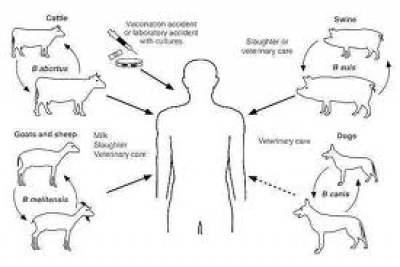
The symptoms are like those associated with many other febrile diseases, but with emphasis on muscular pain and sweating. The duration of the disease can vary from a few weeks to many months or even years. In the first stage of the disease, septicaemia occurs and leads to the classic triad of undulant fevers, sweating (often with characteristic smell, likened to wet hay), and migratory arthralgia and myalgia (joint and muscle pain). Blood tests characteristically reveal leukopenia and anemia, show some elevation of AST and ALT, and demonstrate positive Bengal Rose and Huddleston reactions.
This complex is, at least in Portugal, known as Malta fever. During episodes of Malta fever, melitococcemia (presence of brucellae in blood) can usually be demonstrated by means of blood culture in tryptose medium or Albini medium. If untreated, the disease can give origin to focalizations or become chronic. The focalizations of brucellosis occur usually in bones and joints and spondylodiscitis of lumbar spine accompanied by sacroiliitis is very characteristic of this disease. Orchitis is also frequent in men.
Diagnosis of brucellosis relies on:
- Demonstration of the agent: blood cultures in tryptose broth, bone marrow cultures. The growth of brucellae is extremely slow (they can take until 2 months to grow) and the culture poses a risk to laboratory personnel due to high infectivity of brucellae.
- Demonstration of antibodies against the agent either with the classic Huddleson, Wright and/or Bengal Rose reactions, either with ELISA or the 2-mercaptoethanol assay for IgM antibodies associated with chronic disease
- Histologic evidence of granulomatous hepatitis (hepatic biopsy)
- Radiologic alterations in infected vertebrae: the Pedro Pons sign (preferential erosion of antero-superior corner of lumbar vertebrae) and marked osteophytosis are suspicious of brucellic spondylitis.
Cause
Brucellosis in humans is usually associated with the consumption of unpasteurized milk and soft cheeses made from the milk of infected animals, primarily goats, infected with Brucella melitensis and with occupational exposure of laboratory workers, veterinarians, and slaughterhouse workers. Some vaccines used in livestock, most notablyB. abortus strain 19, also cause disease in humans if accidentally injected. Brucellosis induces inconstant fevers, miscarriage, sweating, weakness, anaemia, headaches, depression, and muscular and bodily pain.
Treatment and prevention
Antibiotics like tetracyclines, rifampicin, and the aminoglycosides streptomycin and gentamicin are effective against Brucella bacteria. However, the use of more than one antibiotic is needed for several weeks, because the bacteria incubate within cells.
The gold standard treatment for adults is daily intramuscular injections of streptomycin 1 g for 14 days and oral doxycycline 100 mg twice daily for 45 days (concurrently). Gentamicin 5 mg/kg by intramuscular injection once daily for seven days is an acceptable substitute when streptomycin is not available or difficult to obtain. Another widely used regimen is doxycycline plus rifampin twice daily for at least six weeks. This regimen has the advantage of oral administration. A triple therapy of doxycycline, with rifampin and cotrimoxazole, has been used successfully to treat neurobrucellosis.

